Tune in every second day this week to see how we spent our family holiday in Central/Northern Greece.
During this year's summer holiday on the Greek mainland, we clocked up a total of 1700 kilometres; the northernmost points we reached were Meteora and the university town of Ioannina (say: YIA-ne-na) with a School of Medicine in the prefecture of Epirus, only 65 kilometers away from the Albanian border. Yiannena is the common way to pronounce the name of the city, but not the common way to spell it: it's usually written as 'Ioannina' or even 'Janina'. It wasn't on our itinerary; we needed to overnight somewhere, after having driven from Pilio to Meteora. We were now weary overheated travellers in need of food, water and rest. We chose Yiannena, because the city is built around a lake, and the idea of being close to a mass of water sounded appealing.
On entering the town in the mid-afternoon, I spotted a sign with directions to a 'κάστρο' (castle), so we headed there, thinking there might be rooms in the area. Its tall stone-built walls bordered the lake (whose common name is pronounced: 'Limni Ioanninon', the second oldest lake after Lake Ohrid in Europe); to Cretans, the moment of approaching water after a long absence resembles Xenophon's Thalatta! Thalatta! We were finally off the main city road: urban arteries leading into Greek cities are often tired-looking dusty places, making the area look polluted, congested and unappealing.
 We were very lucky to find a good place to park; it turned out to be opposite the ferry dock: boats take people on a ten-minute trip every half hour (the €2 ticket is pricey!) to the island in the lake, simply called 'Nisi' (= 'island'). The sound of the clarinet greeted us as we came out of the car - Ipirotes (people from the prefecture of Epirus, which Ioannina belongs to) are very proud of their musical heritage, in the same way as the Cretans. They also display a similar sense of local pride in their customs, especially their cuisine - another point where Crete and Epirus converge. Our short stay on the Nisi was one of the highlights of our trip. Due to time constraints, it was difficult to stay on the Nisi for a long enough time to have a meal there (the last ferry returns to the mainland at 10pm), especially since I was intrigued by the menu choices on the eateries' placards: trout, eel, cyprinid and frogs' legs! I did manage to pick up some sweets: Yiannena is very well known for her unique high quality sweets (known as Yianniotika) all over Greece. Her syrup-drenched pastry styles are often reproduced by many zaharoplastes (confectioners).
We were very lucky to find a good place to park; it turned out to be opposite the ferry dock: boats take people on a ten-minute trip every half hour (the €2 ticket is pricey!) to the island in the lake, simply called 'Nisi' (= 'island'). The sound of the clarinet greeted us as we came out of the car - Ipirotes (people from the prefecture of Epirus, which Ioannina belongs to) are very proud of their musical heritage, in the same way as the Cretans. They also display a similar sense of local pride in their customs, especially their cuisine - another point where Crete and Epirus converge. Our short stay on the Nisi was one of the highlights of our trip. Due to time constraints, it was difficult to stay on the Nisi for a long enough time to have a meal there (the last ferry returns to the mainland at 10pm), especially since I was intrigued by the menu choices on the eateries' placards: trout, eel, cyprinid and frogs' legs! I did manage to pick up some sweets: Yiannena is very well known for her unique high quality sweets (known as Yianniotika) all over Greece. Her syrup-drenched pastry styles are often reproduced by many zaharoplastes (confectioners).
Because of my foreign education, my knowledge of modern Greek history has huge gaps often filled in by my husband. As we walked around the Nisi (very touristy, hawkers everywhere, vehicle-free, with about 250 permanent residents all involved in the tourist/food industry, no accomodation facilities), he told us all about the legend of Ali Pasa and his connection with Ioannina and the Nisi. Ali Pasa was not the nicest of rulers, but he had a soft spot for Greece. Of his many wives, his favorite was the Greek one, Vasiliki (his other Greek favorite was Frosini, his son's mistress). Because of his close Greek associations, he got into trouble with his superiors (the Sultan of the Ottoman Empire), so he sought refuge in a monastery on the Nisi, when he was killed in 1822. The place of his murder is now a museum holding artifacts reminiscent of the time Ali Pasa lived in the
house, at about the time Greece began shaping herself into a
modern independent state.
 Ali Pasa was an Albanian Moslem from Tepelene; in other words, he was from the prefecture known in Greece as Epirus, which was much larger in pre-WW2 times. In Greece,
people born in the Greek prefecture of Epirus are called Ipirotes, while
Greek-speaking Christians born in southern Albania, which borders Epirus, are called
Vorio-Ipirotes in Greece, which means Northern Ipirotes, referring to the former
Greek territory. North Epirus and South Epirus are now located in
different countries, and North Epirus goes by a different name. Ioannina is also a favoured town for Albanian immigrants living and working
in Greece - it has a cheap market with all sorts of goods available
at reasonable prices for Albanians crossing the border back into their homeland, to see relatives or for a holiday.
Ali Pasa was an Albanian Moslem from Tepelene; in other words, he was from the prefecture known in Greece as Epirus, which was much larger in pre-WW2 times. In Greece,
people born in the Greek prefecture of Epirus are called Ipirotes, while
Greek-speaking Christians born in southern Albania, which borders Epirus, are called
Vorio-Ipirotes in Greece, which means Northern Ipirotes, referring to the former
Greek territory. North Epirus and South Epirus are now located in
different countries, and North Epirus goes by a different name. Ioannina is also a favoured town for Albanian immigrants living and working
in Greece - it has a cheap market with all sorts of goods available
at reasonable prices for Albanians crossing the border back into their homeland, to see relatives or for a holiday.
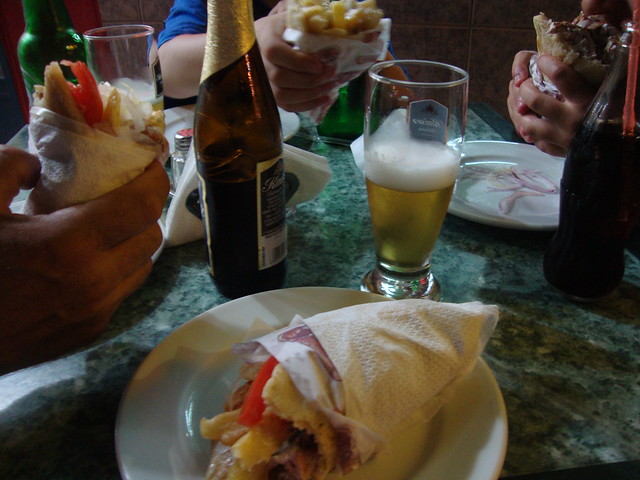
We had to get back to the car and find a hotel for the night (there is no tourist accommodation on the island). I found a text message from a friend: "Try Perama for rooms." As we drove through this very family-oriented busy noisy suburb bordering the lake, we saw a sign giving directions to a cave (Spilia Peramatos). Perama turned out to have many cheap rooms available (we got two doubles, 20 euro each per night, ie 40 euro in total, no breakfast), most taken up by foreign tourists. The cave and the lake district attract hikers, trampers and nature lovers from all over Europe.
Perama is a strange place for these people to meet up, what with its typical haphazard Greek development: the rooms consist mainly of houses and apartment blocks that were initially made to house the locals and were later turned into rooms to meet the demands of the tourist industry. They sit side-by-side with the tourist stores consisting mainly of silverware merchants - the trade of the silversmith in Ioannina has its origins in the Byzantine era. Add to that the general melee of stores making up a Greek neighbourhood (baker, confectioner, frontistirio, mini-market, grocery, butcher, etc), and you get the picture. It's the strangest place to see foreign tourists, yet here they are, combining the unique biotope of the lake district of Iaonnina with grass roots Greek culture.
The next morning, we breakfasted on the juice of the last remaining oranges we had carried with us from home and headed to the cave, which we realised is regarded as a very significant one in Europe. The cave of Perama was discovered accidentally in WW2 when the locals were trying to hide from the Nazis. It has formed over a period of 2 million years (according to the density of one of the stalactites) by the receding lake waters (Limni Ioanninon was much bigger in pre-historic times). It has many large open chambers (not claustrophobic at all!) filled with stalactites and stalagmites of different shapes and sizes. The tour lasted one hour (with a pricey ticket - 7 euro per person, 3 euro for children).
By midday, we were back on the road again, heading down to Central Greece, to complete the circle that we had started four nights earlier. Eighteen hours was not enough to see much, but what we did manage to see in that short period we spent in Ioannina made a great impression on all of us. What will remain in my mind most of all is the locals' hospitality and their interest in us on hearing that we were from Crete, exactly what one would expect from the Greek notion of filoxenia.
Not all photos are my own: I have used some common-licence photos from the web.
©All Rights Reserved/Organically cooked. No part of this blog may be reproduced and/or copied by any means without prior consent from Maria Verivaki.
During this year's summer holiday on the Greek mainland, we clocked up a total of 1700 kilometres; the northernmost points we reached were Meteora and the university town of Ioannina (say: YIA-ne-na) with a School of Medicine in the prefecture of Epirus, only 65 kilometers away from the Albanian border. Yiannena is the common way to pronounce the name of the city, but not the common way to spell it: it's usually written as 'Ioannina' or even 'Janina'. It wasn't on our itinerary; we needed to overnight somewhere, after having driven from Pilio to Meteora. We were now weary overheated travellers in need of food, water and rest. We chose Yiannena, because the city is built around a lake, and the idea of being close to a mass of water sounded appealing.
Former mosques adorn each corner of the castle - the black and white photo shows the castle 100 years ago; this is where we parked our car, unaware of what was above us, as the road by the lake is now lined with trees. The Nisi (Island) has a settlement on it - 250 people live there permanently and all trade is mainly tourist-oriented.
On entering the town in the mid-afternoon, I spotted a sign with directions to a 'κάστρο' (castle), so we headed there, thinking there might be rooms in the area. Its tall stone-built walls bordered the lake (whose common name is pronounced: 'Limni Ioanninon', the second oldest lake after Lake Ohrid in Europe); to Cretans, the moment of approaching water after a long absence resembles Xenophon's Thalatta! Thalatta! We were finally off the main city road: urban arteries leading into Greek cities are often tired-looking dusty places, making the area look polluted, congested and unappealing.
 We were very lucky to find a good place to park; it turned out to be opposite the ferry dock: boats take people on a ten-minute trip every half hour (the €2 ticket is pricey!) to the island in the lake, simply called 'Nisi' (= 'island'). The sound of the clarinet greeted us as we came out of the car - Ipirotes (people from the prefecture of Epirus, which Ioannina belongs to) are very proud of their musical heritage, in the same way as the Cretans. They also display a similar sense of local pride in their customs, especially their cuisine - another point where Crete and Epirus converge. Our short stay on the Nisi was one of the highlights of our trip. Due to time constraints, it was difficult to stay on the Nisi for a long enough time to have a meal there (the last ferry returns to the mainland at 10pm), especially since I was intrigued by the menu choices on the eateries' placards: trout, eel, cyprinid and frogs' legs! I did manage to pick up some sweets: Yiannena is very well known for her unique high quality sweets (known as Yianniotika) all over Greece. Her syrup-drenched pastry styles are often reproduced by many zaharoplastes (confectioners).
We were very lucky to find a good place to park; it turned out to be opposite the ferry dock: boats take people on a ten-minute trip every half hour (the €2 ticket is pricey!) to the island in the lake, simply called 'Nisi' (= 'island'). The sound of the clarinet greeted us as we came out of the car - Ipirotes (people from the prefecture of Epirus, which Ioannina belongs to) are very proud of their musical heritage, in the same way as the Cretans. They also display a similar sense of local pride in their customs, especially their cuisine - another point where Crete and Epirus converge. Our short stay on the Nisi was one of the highlights of our trip. Due to time constraints, it was difficult to stay on the Nisi for a long enough time to have a meal there (the last ferry returns to the mainland at 10pm), especially since I was intrigued by the menu choices on the eateries' placards: trout, eel, cyprinid and frogs' legs! I did manage to pick up some sweets: Yiannena is very well known for her unique high quality sweets (known as Yianniotika) all over Greece. Her syrup-drenched pastry styles are often reproduced by many zaharoplastes (confectioners).
Trout, eel, cyprinid and frogs' legs - and Yianniotika sweets: the further up north you travel in Greece, the less Mediterranean the cuisine (and the environment) feels. The colours and flavours of the food change, but the focus is still very much on the same Greek pride that dominates food, which is local produce. The sweets convey a sense of former times, during Ottoman rule. I could imagine Ali Pasa gorging on these with Vasiliki or Frosini sitting by his side and a silver musket hanging from his waist in his refuge on the island (see below), digesting it all with a puff on the nargile.
Nisi Island of Ioannina - this slideshow approximates my own photos of our trip to Ioannina, Ήπειρος, Ελλάδα, created by TripAdvisor.
 Ali Pasa was an Albanian Moslem from Tepelene; in other words, he was from the prefecture known in Greece as Epirus, which was much larger in pre-WW2 times. In Greece,
people born in the Greek prefecture of Epirus are called Ipirotes, while
Greek-speaking Christians born in southern Albania, which borders Epirus, are called
Vorio-Ipirotes in Greece, which means Northern Ipirotes, referring to the former
Greek territory. North Epirus and South Epirus are now located in
different countries, and North Epirus goes by a different name. Ioannina is also a favoured town for Albanian immigrants living and working
in Greece - it has a cheap market with all sorts of goods available
at reasonable prices for Albanians crossing the border back into their homeland, to see relatives or for a holiday.
Ali Pasa was an Albanian Moslem from Tepelene; in other words, he was from the prefecture known in Greece as Epirus, which was much larger in pre-WW2 times. In Greece,
people born in the Greek prefecture of Epirus are called Ipirotes, while
Greek-speaking Christians born in southern Albania, which borders Epirus, are called
Vorio-Ipirotes in Greece, which means Northern Ipirotes, referring to the former
Greek territory. North Epirus and South Epirus are now located in
different countries, and North Epirus goes by a different name. Ioannina is also a favoured town for Albanian immigrants living and working
in Greece - it has a cheap market with all sorts of goods available
at reasonable prices for Albanians crossing the border back into their homeland, to see relatives or for a holiday.
In the late evening, we ate souvlaki for dinner, after strolling around Perama on that warm summer's evening. The area was buzzing with the noise of children on bikes, gypsies in vans, people on verandahs and balconies and cars whizzing up and down the road. A note on souvlaki in central and northern Greece: your choice of meat (pork or chicken, sausage or kebab, sometimes beef) rolled in a pita with tzatziki, fries, onion, tomato, mustard and ketchup (the latter two are never added to souvlaki in Crete, but I've noticed that the newer souvlatzidika offer them at the tables). It pays to know this so that you can ask to omit anything you'd prefer not to have included!
We had to get back to the car and find a hotel for the night (there is no tourist accommodation on the island). I found a text message from a friend: "Try Perama for rooms." As we drove through this very family-oriented busy noisy suburb bordering the lake, we saw a sign giving directions to a cave (Spilia Peramatos). Perama turned out to have many cheap rooms available (we got two doubles, 20 euro each per night, ie 40 euro in total, no breakfast), most taken up by foreign tourists. The cave and the lake district attract hikers, trampers and nature lovers from all over Europe.
Perama is a strange place for these people to meet up, what with its typical haphazard Greek development: the rooms consist mainly of houses and apartment blocks that were initially made to house the locals and were later turned into rooms to meet the demands of the tourist industry. They sit side-by-side with the tourist stores consisting mainly of silverware merchants - the trade of the silversmith in Ioannina has its origins in the Byzantine era. Add to that the general melee of stores making up a Greek neighbourhood (baker, confectioner, frontistirio, mini-market, grocery, butcher, etc), and you get the picture. It's the strangest place to see foreign tourists, yet here they are, combining the unique biotope of the lake district of Iaonnina with grass roots Greek culture.
The cave is intact, and no part has been damaged for tourism, except at one point when some stalactites were trimmed to make a suitable tourist pathway. A natural possible exit of the cave has been left as it was discovered (it isn't open), unbroken in order to keep the cave in pristine condition, and another exit has been formed in the rock for people to exit the cave without walking the same route back to the main entrance. The photo below shows the point where a few stalactites were cut: stalactites (growing from the ceiling) are hollow and grow from the outside, while stalagmites (growing on the ground) are compact and grow as the minerals drop onto the floor. My photos are taken without flash - check out the cave on this site.
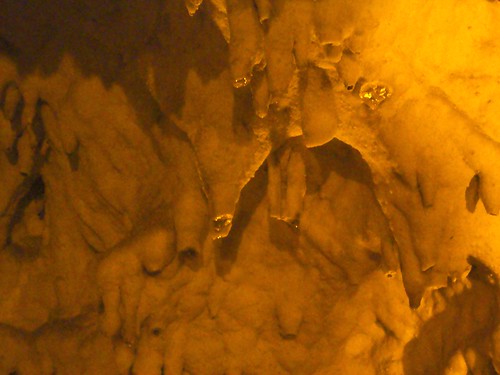

The next morning, we breakfasted on the juice of the last remaining oranges we had carried with us from home and headed to the cave, which we realised is regarded as a very significant one in Europe. The cave of Perama was discovered accidentally in WW2 when the locals were trying to hide from the Nazis. It has formed over a period of 2 million years (according to the density of one of the stalactites) by the receding lake waters (Limni Ioanninon was much bigger in pre-historic times). It has many large open chambers (not claustrophobic at all!) filled with stalactites and stalagmites of different shapes and sizes. The tour lasted one hour (with a pricey ticket - 7 euro per person, 3 euro for children).
This photograph has been taken at a high point at the cave's exit - the lake would have extended up to this point in pre-historic times.
By midday, we were back on the road again, heading down to Central Greece, to complete the circle that we had started four nights earlier. Eighteen hours was not enough to see much, but what we did manage to see in that short period we spent in Ioannina made a great impression on all of us. What will remain in my mind most of all is the locals' hospitality and their interest in us on hearing that we were from Crete, exactly what one would expect from the Greek notion of filoxenia.
Not all photos are my own: I have used some common-licence photos from the web.
©All Rights Reserved/Organically cooked. No part of this blog may be reproduced and/or copied by any means without prior consent from Maria Verivaki.
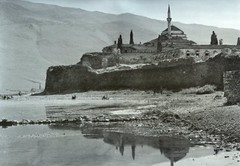
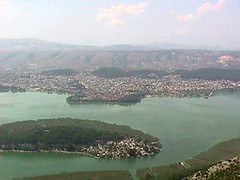
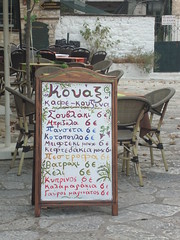


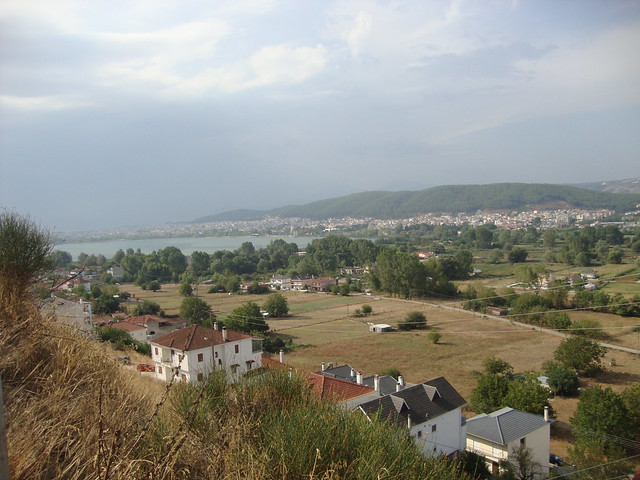
Maria, check out Aliki Vougiouklaki in the 1959 movie "Astero" in the Perama Cave http://www.youtube.com/watch?v=kKy44y4ImZY&feature=related Vougiouklaki actually fainted in the cave and wouldn't respond for a while to the calls of the film crew.
ReplyDeleteAlso here is the famous heartbreaking song from the movie "Astero apopse ta vouna giati einai pikramena" http://www.youtube.com/watch?v=LB6aE6fIRrE&feature=related
i always thought Vougiouklaki was the cause of all evil in greek society (thank god the film has been subtitled for my benefit): the way she spun round those stalagmites is akin to pole dancing - having said that, i now show renewed interest in old black and white greek films (i think vougiouklaki also filmed in makrinitsa, which is where we had overnighted before staying in perama)
ReplyDeleteBut she put Perama cave, Makrinitsa, Aigina, Antiparos (see Mantalena) wherever she filmed on the map. This is when it all started. It's so nostalgic to see these places back then when almost nobody travelled in Greece. Maybe only when in political exile.
ReplyDeleteOn my trip to Greece several years ago I spent several days at a hotel within the cities walls. It is a special place full of wonderful memories enroute to our goal of the Zagorian villages and Meteora.
ReplyDeleteWhat a beautiful place and I think that Easter was there.
ReplyDeleteOne more reason to go back.
Thank you for review.
See you soon.
As an Epirote, I have seen the magic and the spleandour of this region, smelled it, drunk it, eaten it and walked it barefoot. And let us not forget that we make the best pites, Feta and yoghurt. OK not me, exactly.
ReplyDeleteZHTO EPIROS. ZHTO FILIATES
ReplyDelete